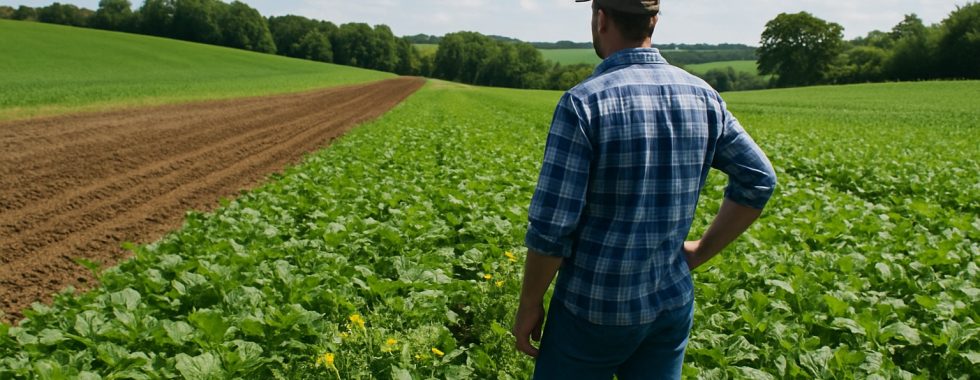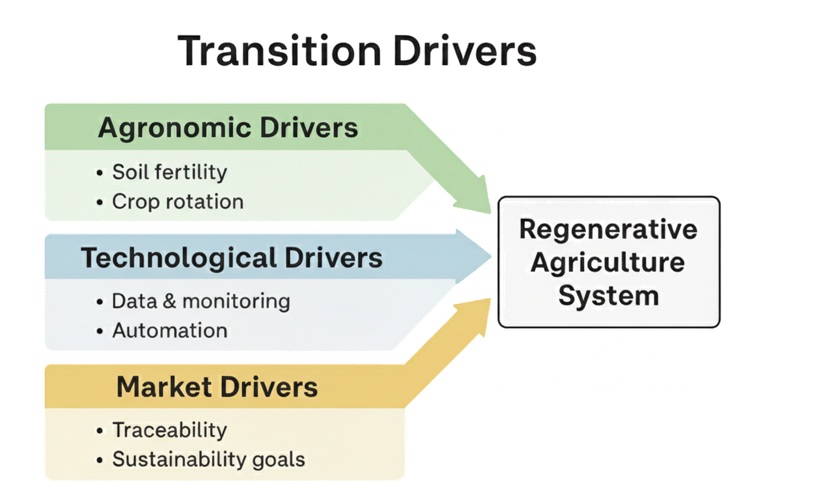Transitioning to Regenerative Agriculture
A Practical Guide for Farmers and Agribusinesses
Why This Transition Is Happening
Farmers today face tough challenges: soils are degrading, weather is less predictable, inputs are expensive, regulations are tightening, and buyers are demanding more. That’s why many farms are shifting toward regenerative agriculture. More than a buzzword, it is a practical way to rebuild soils, maintain profitability, and keep farming viable for the future. This shift aligns with the broader principles of agroecology and sustainable food systems promoted by the Food and Agriculture Organization (FAO), which emphasize resilience, resource efficiency, and ecosystem balance.
Regenerative systems deliver tangible benefits: higher organic matter, improved water retention, reduced reliance on fertilizers and pesticides, stronger biodiversity, and in some markets, premium prices. But this transition is not immediate. Moving from conventional to regenerative farming is a gradual process that requires planning, patience, and investment.
This guide explains what that process involves: agronomy, economics, risks, and how tiered adoption models can help farmers and agribusinesses progress systematically.
Where to Start the Change
Conventional farming often follows a linear path: apply inputs, grow crop, harvest yield. Regenerative farming views the system as interconnected: soil, plants, livestock, water, and biodiversity all influence each other. Transitioning requires a mindset shift. Instead of maximizing yield every season, the focus turns to resilience, long-term profitability, and soil health.
This does not mean discarding technology. It means using tools that regenerate rather than deplete. Many farmers start gradually, with mixed practices: reduced tillage combined with precision fertilizer placement, cover crops alongside satellite monitoring, or livestock integrated with digital grazing management.
Agronomic Considerations in Transition
1. Soil Health as the Foundation
Every transition begins with soil. Conduct a baseline assessment of organic matter, compaction, pH, biological activity, and nutrient status. Understanding the starting point is essential to measure progress and avoid yield losses.
- Short term: plant cover crops, apply manure or compost, and stimulate microbial activity.
- Medium term: gradually reduce synthetic nitrogen and pesticides, relying more on natural nutrient cycling.
- Long term: build soils that sustain productivity with minimal external inputs.
A key challenge is timing. In the early years, nutrient release from organic matter rarely matches crop demand, requiring supplemental fertilization to prevent yield reductions.
2. Crop Rotations and Biodiversity
Regenerative systems rely on diverse rotations. Monocultures are not sustainable. Incorporate legumes to reduce nitrogen costs, deep-rooted crops to break compaction, and flowering species to support pollinators and beneficial insects.
Examples:
- In temperate regions, a maize-soy rotation can expand into multi-year sequences with cereals, legumes, and cover crops.
- In vegetable systems, fallow cover crops or green manures between high-value crops improve soil balance and disrupt pest cycles.
3. Tillage Reduction
Reducing tillage protects soil structure and microbial life. Transitioning usually involves stages: deep plowing -> shallow tillage -> strip-till -> direct seeding.
Challenges include managing residues, weed pressure, and cold spring soils. Mechanical weeding, mulching with cover crops, or targeted herbicide use can support the adjustment.
4. Pest and Disease Management
Over time, regenerative systems reduce pest pressure through biodiversity. But during early transition, reducing pesticides without alternatives can increase risks. Do not eliminate crop protection abruptly. Use Integrated Pest Management (IPM): scout fields, respect thresholds, choose resistant varieties, and intervene only when necessary.
5. Nutrient and Water Management
Regenerative practices alter nutrient cycling and water dynamics. Precision irrigation, staged nitrogen, and careful potassium and calcium management become more important when soils are biologically active. Sensors, satellite imagery, and decision-support tools help match supply with demand and minimize losses.
Economic Considerations in Transition
1. Short-Term Risk vs. Long-Term Gain
Expect variability in the first years: yields may decline, and costs will not immediately fall. Cutting inputs too quickly risks crop failure. Plan financially for this adjustment period -secure financing, diversify income streams, or establish buyer contracts that reward regenerative practices.
2. Market Incentives and Premiums
Demand for regenerative products is increasing, and some buyers offer premiums. However, premiums are usually tied to verified outcomes and progress, not initial adoption. Engage early in programs that monitor improvements over time.
3. Access to Capital
Transitioning requires investment. New equipment may be needed for cover crops, compost spreading, or monitoring. Seek credit, grants, or participate in cooperatives that share machinery and resources. Networks often accelerate adoption.
4. Documentation and Verification
Markets and lenders require evidence. Keep records of fertilizer use, tillage, cover crop mixes, and biodiversity practices. Digital tools simplify this, but farmers must commit to consistent, transparent documentation.
Frameworks and Tiers of Adoption
There is no universal Initial/Intermediate/Advanced program, but tiered systems are useful for showing progress. They help farmers demonstrate improvements and help buyers understand value.
Suggested Tier Framework for Regenerative Transition
| Tier | What It Means | Key Practices | Technology & Monitoring | Expected Outcomes |
|---|---|---|---|---|
| Initial (Entry) | First steps, clear commitment |
|
Digital logs of tillage/fertilizer use Simple soil testing apps or spreadsheets |
Early signs of soil cover and microbial activity; no measurable outcomes yet |
| Intermediate | Core regenerative practices established |
|
|
Improved soil structure, increase in organic matter, reduced input costs |
| Advanced | Fully regenerative and verified |
|
|
Long-term resilience, premium access, and reduced input reliance |
Case Study: The “SustainGrain” Program for Wheat
Alongside the general framework, it is useful to look at how a real program was structured. At Cropaia, we developed SustainGrain for a company focused on wheat supply chains. It mirrors the Bronze, Silver, and Gold structure, but with crop-specific requirements and support systems.
Bronze Level (Foundations)
- Training and mentorship: workshops, field demonstrations, and mentoring support.
- Record-keeping: journals or digital logs capturing soil, crop, pest, and biodiversity data.
- Soil health assessment: comprehensive soil testing and nutrient management planning.
- Plant cover crops and retain residues on at least 30% of cultivated area.
- Initial steps toward no-till: reduce tillage intensity.
Silver Level (Advancing Sustainability)
- Transition to full no-till.
- Regular soil testing and split nutrient applications.
- Plant cover crops on at least 50% of acreage.
- Multi-year crop rotations to disrupt pest and disease cycles.
- Biodiversity practices: hedgerows, IPM, and habitat corridors.
- Water management: irrigation schedules based on soil and weather monitoring.
- Residue retention on 50% of fields.
- Erosion control in high-risk areas.
Gold Level (Advanced Proficiency)
- Cover crops on 100% of land, advanced soil health management.
- Variable-rate fertilizer applications supported by precision technology.
- Agroforestry, wildlife habitats, buffer zones, windbreaks, and shelterbelts integrated into the farm.
- Diversified, data-driven rotations.
- Water conservation: ponds, recycling systems, advanced scheduling.
- Residue retention across all fields.
- Verified monitoring and reporting for buyers and auditors.
This case study shows how the same tier logic can be applied in a crop-specific program, combining agronomy, technology, and training.
Pathways to Transition
Think of transition as a structured process rather than a single change. Each stage builds capacity for the next, reducing the risk of setbacks.
- Assessment: Begin with comprehensive testing of soils, biodiversity, and input use to establish a baseline. This step should include mapping problem areas, identifying compaction zones, and quantifying organic matter. The clearer your starting point, the more realistic your targets will be.
- Pilot: Trial regenerative practices on a manageable portion of the farm. For example, test cover crops on one block, experiment with reduced tillage on a second, and evaluate how each system performs. Pilots give you real data without risking the whole farm.
- Scaling: Expand the successful practices across larger areas, adjusting equipment and management systems. This is when you begin phasing down synthetic inputs and investing in rotations, biodiversity corridors, or irrigation changes.
- Verification: Connect with buyer or certification programs that recognize progress. Verification often requires soil sampling, biodiversity tracking, and transparent record-keeping. This step links agronomy with potential premiums and market access.
- Integration: The farm system is redesigned for regeneration. By this stage, cover crops, rotations, nutrient management, biodiversity features, and digital monitoring are all standard. Integration is not about isolated practices, but about a resilient system that sustains itself.
Overcoming Challenges
Transitioning brings predictable obstacles. Addressing them early helps keep the process on track.
- Yield variability: In the first years, yields may drop due to soil adjustments and lower synthetic inputs. Start with smaller areas, adjust fertility programs, and use supplemental fertilization where needed to stabilize production. Monitor both yield and quality to capture a full picture of performance.
- Weed pressure: Reduced tillage and cover crops change weed dynamics. Expect shifts in species, sometimes favoring perennials or herbicide-resistant types. Use competitive rotations, mulches, mechanical cultivation, and where necessary, carefully timed herbicide applications.
- Economic strain: Regenerative practices may require new machinery, seed, or monitoring technology. Finance the transition with credit, grants, or long-term contracts that share risk. Building budgets that anticipate a temporary dip avoids shocks when yields or margins fluctuate.
- Knowledge gaps: Adoption involves practices that are unfamiliar to many farmers. Close the gap through farmer networks, extension programs, digital decision-support, and training sessions. Sharing experiences with peers accelerates learning and prevents costly mistakes.
Conclusion: A Regenerative Future Is Built in Steps
Transitioning to regenerative agriculture requires redesigning farming systems across agronomy, economics, and management. It takes time and planning, but the benefits are clear: healthier soils, lower input costs, stronger markets, and farms that withstand climate and market shocks.
The pathway is easiest to follow when seen in tiers: begin with cover crops and record-keeping, advance to rotations and reduced inputs, and eventually verify soil, biodiversity, and profitability gains.
The future of farming will not be measured only in yields, but in resilience. Regenerative agriculture offers the route -one field, one season, one tier at a time.


